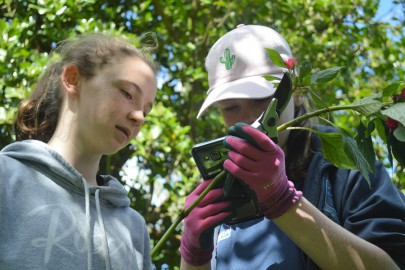Mt Albert Grammar, Auckland
In this section
-
Participating schools
- Curious Minds visit Lincoln
- Franz Josef & Fox Glacier Schools
- Greymouth High School
- Haast School
- Halswell Domain
- Halswell School
- Heathcote Valley School
- Kaniere School
- Kaniere visit Lincoln
- Hokitika Primary
- Leeston Consolidated School
- Manuka Primary School
- Mission Heights
- Mt Albert Grammar
- Paroa School
- Rudolf Steiner School
- Takapuna Grammar
- TKKM
- Wakaaranga Primary School
- Whataroa School

Students using the smartphone apps.
Hugh Gourlay, also from MWLR at Lincoln, joined Murray Dawson to contribute his biocontrol expertise – as well as bringing along some biocontrol insects for the students to examine.
Although Mt Albert Grammar School is somewhat outside our target demographic of usually low decile, remote and hard-to-reach rural schools, there were good reasons to visit this school in Auckland city. Mt Albert Grammar have taken on an active conservation project to monitor mothplant (Araujia hortorum), in partnership with Auckland Council, so wider exposure to our weed education programme that engages the latest technology for identifying and recording plants was seen to be of special benefit that could also contribute towards their ongoing work. It was the school that contacted us when they learned of our successful Curious Minds funding.
Michael Ashby and Helen Dunham were the two school teachers that we engaged with along with two of their classes comprising 34 students.
We were based in the school hall for the first day, and our educator Monique Russell of the TLC did a great job presenting the content and activities, which she adjusted for the older Y9-11 audience. We finished the first day by using the weeds identification app in a foray to a wildland area within the school grounds.
The following day, we undertook a full field trip to the nearby Roy Clements Walkway.
In addition to the above named people, others who joined us for the field day were Katie Jones (General Manager of the TLC), Adrienne De Melo (Outreach and Education Coordinator, DOC Auckland), and Sel Arbuckle (a local volunteer and plant expert). Sel has worked extensively maintaining the walkway and is part of the St Lukes Environmental Protection Society.
The students were well mannered and attentive, and enjoyed being outdoors, especially considering the pressures of their imminent end of year exams. The school nominated their Y11 student Lois to attend our Lincoln weeds workshop, who proved to be an excellent choice.
What were some of the plants that we found?
During our weed 'treasure-hunt' within the school grounds we used the identification app to learn how to identify widespread and common weeds, such as:
- broad-leaved dock (Rumex obtusifolius)
- creeping buttercup (Ranunculus repens)
- ivy (Hedera)
- large bindweed (Calystegia silvatica).
Thanks to the efforts of local volunteers, the boarded Roy Clements Walkway itself was relatively weed free. However, a side track at the western end of the walkway led to a very weedy spot, due to plants 'jumping the garden fence' from an adjacent empty section. This provided an excellent site to study and record numerous weed species. In addition to the common weeds found the previous day, at the walkway we found numerous invasive species, including:
- brush wattle (Paraserianthes lophantha)
- mignonette vine (Anredera cordifolia)
- onion weed (Allium triquetrum)
- tradescantia (Tradescantia fluminensis)
- woolly nightshade (Solanum mauritianum).
We found a tree privet (Ligustrum lucidum) actively resisting control measures by resprouting after having been cut down.
We found several attractive garden plants, widely grown but obviously escaping cultivation at our study site. These included:
- bartlettina (Bartlettina sordida)
- black-eyed Susan vine (Thunbergia alata)
- florist's cineraria (Pericallis × hybrida)
- ivy-leaved toadflax (Cymbalaria muralis)
- jasmine (Jasminum polyanthum)
- nasturtium (Tropaeolum majus)
- pale pink-sorrel (Oxalis incarnata)
- shrub balsam (Impatiens sodenii).
Native species observed by the students were:
- Haloragis erecta ssp. erecta
- karaka (Corynocarpus laevigatus)
- kawakawa (Piper excelsum)
- mahoe (Melicytus ramiflorus)
- manuka (Leptospermum scoparium)
- putaputaweta (Carpodetus serratus)
- totara (Podocarpus totara)
- whau (Entelea arborescens).
Many of these natives form part of restoration plantings at the Roy Clements Walkway.















